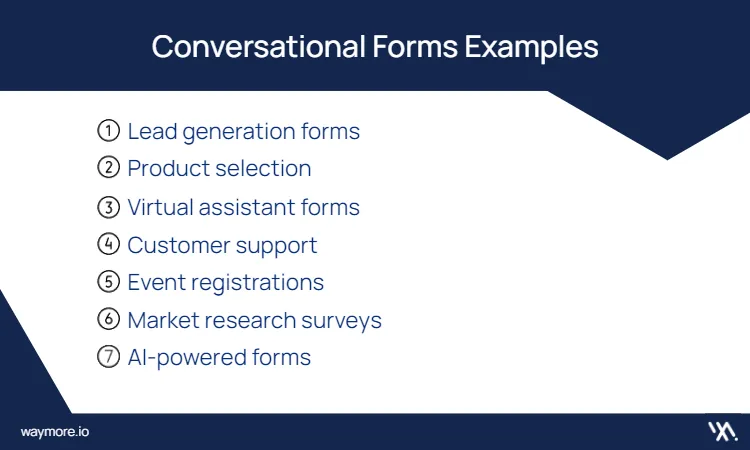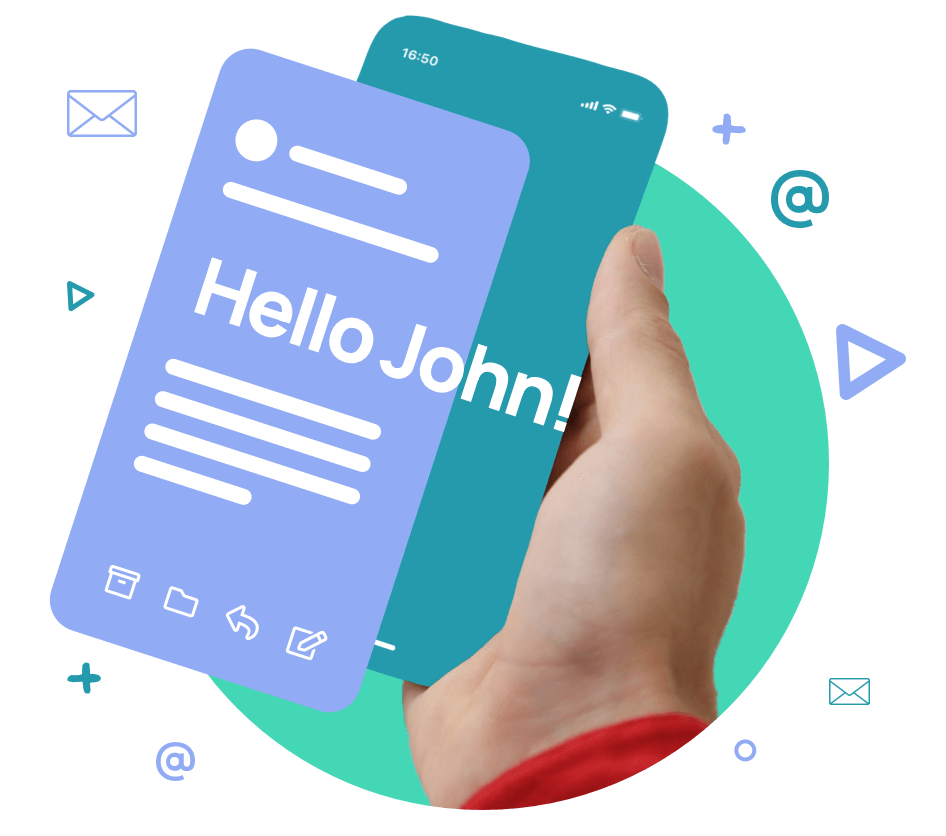Quick Links
The way we collect information online is evolving. Conversational forms are a revolutionary new approach that transforms static forms into engaging dialogues.
Traditional online forms are often a pain point for users. They can be lengthy, confusing, and downright frustrating to complete. This can lead to a high number of abandoned forms and missed opportunities for businesses.
Conversational forms, also known as natural language forms or conversational web forms, are a new type of online form that doesn’t use the traditional static format, it feels more like a chat with a friend. These interactive forms ask one clear question at a time, and the next question depends on your previous answer. Think of it like a back-and-forth conversation where the topics adapt based on what you say. This makes filling out forms faster, easier, and even enjoyable, ultimately leading to better results for businesses.
How conversational forms work
Traditional online forms can feel like a chore. They often bombard you with multiple questions upfront, regardless of your specific needs. This can be confusing and lead to form abandonment.
Conversational forms take a different approach. They break down the process into a series of clear, easy-to-understand questions. The form asks one question at a time, and the next question depends on your previous answer.
This “conditional logic” tailors the experience to your specific situation, making it feel more like a conversation than filling out a form.
Key features that make conversational forms user-friendly:
- Simple, clear questions: The questions are straightforward and easy to answer, eliminating any confusion.
- Conditional logic: Based on the responses, the form adapts to the submitor’s needs, keeping the conversation relevant.
- Progress indicators: Users can see how far they’ve progressed through the form, which can help with motivation.
- Friendly and casual language: Conversational forms use a more informal tone, making the experience more enjoyable.
Get inspiration on how to create Conversational Forms in our latest blog post.
Benefits of conversational forms
A strong conversational data strategy can be instrumental in nurturing leads and driving sales. According to a Forrester report, “B2B Marketers Must Invest In a Conversational Data Strategy”.
Here are a few of the most important conversational forms benefits:
- Increased form completion rates: Because they’re engaging and easy to use, people are more likely to finish conversational forms compared to traditional ones.
- Improved lead generation: Conversational forms make it easier for people to give you the info you need. This means you get better “leads” – potential customers who are actually interested in what you offer.
- Boosted customer engagement: Conversational forms create a more interactive experience that can help users stay engaged with your brand.
- Reduced form abandonment: No one likes starting a form and giving up halfway through. Conversational forms ask one question at a time, keeping people motivated to finish.
- Valuable customer data: These forms can gather valuable information about your customers, like what they need and what challenges they face. This info helps you improve your marketing and sales efforts.
Are conversational web forms right for your business?
Conversational forms are a great option for businesses of all sizes. They are particularly well-suited for businesses that:
- Want to improve their lead generation efforts
- Need to collect more customer data
- Are looking for ways to improve customer engagement
For a deeper dive into the benefits of conversational forms, and how they compare to classic forms, check out our blog post: Conversational vs Classic Forms: Are They Really Better?
Conversational forms examples

Conversational forms can be used for a variety of purposes, such as:
1. Lead generation forms
Imagine you run a website that sells bikes.
A traditional lead generation form might ask for a user’s name, email, and what type of bike they’re looking for all at once.
A conversational form could start by asking, “What kind of riding are you interested in?” Based on the answer (e.g., mountain biking, road cycling), it could then ask, “Are you looking for a beginner or experienced rider bike?”
This way, you gather info from people most likely to buy from you.
2. Product selection
Imagine a visitor on your furniture store’s website wants a new couch.
A conversational form could ask, “What size couch are you looking for?” and then, based on the answer, ask things like “Do you prefer a leather or fabric couch?”
This helps users narrow down their choices and find the perfect item.
Learn how to create conevrsational forms for product recommendations in WayMore’s latest article.
3. Virtual assistant forms
Imagine having a helpful assistant on your website, ready to guide users through a process or answer questions. Virtual assistant forms use a series of questions to understand the user’s needs. Then they provide tailored recommendations or information.
For example, a clothing store might use a virtual assistant form to help recommend outfits.
The form could start by asking, “What’s the occasion?” Based on your answer (e.g., job interview or casual dinner), it can suggest styles like suits or dresses and ask about preferred colors.
This personalized approach makes the shopping experience more efficient and enjoyable for users.
4. Customer support
Imagine a customer on your bank’s website can’t remember their password.
A conversational bank form might ask, “What can’t you access today?” If the answer is “password,” the form can guide the customer through resetting it with step-by-step instructions. For trickier problems, the form can connect them with a real person at the bank to chat with.
This makes customer support faster because people can fix simple issues themselves, but there’s still help available for anything more complicated.
5. Event registrations
Imagine you’re hosting a tech conference.
A conversational form could ask attendees, “What topics are you most interested in learning about?”
This information can help you tailor the event to your audience’s interests.
6. Market research surveys
Imagine you’re a company that makes sneakers.
You could use a conversational form to ask teenagers questions about the styles and features they look for in sneakers.
This can give you valuable insights to help you develop new products.
Surveys and questionnaires are both effective practices.
7. AI-powered forms
Imagine you’re on a travel website and feeling overwhelmed by all the destination options.
An AI-powered form might ask, “What kind of experience are you looking for?” and use your answer (e.g., relaxation or adventure) to suggest destinations or activities that fit your preferences. The form could even learn from your previous answers and adjust its recommendations as you go.
This level of personalization can significantly improve user satisfaction and lead to better conversions.
Getting started with conversational forms
Conversational forms are changing the game for businesses by making information collection more interactive and user-friendly. Here’s how to get started:
- User-Friendly Platforms: Forget complicated coding! Several platforms offer a drag-and-drop system, allowing anyone to create conversational forms. Build the conversation step-by-step, making it easy to customize the experience for your needs.
- Ready-Made Templates: Many platforms offer pre-built conversational form templates for common situations, like lead generation or customer support. These templates provide a solid foundation that you can easily customize to fit your specific needs.
- AI Assistance: AI-powered platforms can leverage artificial intelligence to suggest the best way to phrase questions or order them for optimal results. Let AI be your guide to creating even more effective conversational forms.
Implementing conversational forms is a straightforward process with significant benefits. User-friendly platforms, readily available templates, and optional AI assistance make it easier than ever to create engaging forms. This, in turn, enhances your data collection efforts and ultimately helps your business flourish.
Conclusion
For years, businesses have focused on “form optimization strategies” to improve traditional online forms. This typically involved tweaking layouts and design elements. Conversational forms, however, represent a revolutionary shift in this approach.
These forms ditch the static format and mimic a natural conversation. They ask clear, one-step-at-a-time questions, and the next question adapts based on your previous answer. This personalization makes the experience engaging and user-friendly, leading to higher completion rates and better quality data for businesses.
So, if you’re looking for a way to revamp your online data collection and boost user engagement, conversational forms are definitely worth exploring.
They’re a powerful tool for businesses of all sizes, and with user-friendly platforms readily available, getting started is easier than ever.
Curious to learn more? WayMore’s experts are ready to chat!
FAQs
Conversational forms are a great fit for many situations, but they might not be ideal for everything. They excel when you want to collect detailed information or guide users through a process with multiple steps. However, for very short forms with just a few questions, a traditional format might be simpler.
The time it takes to create a conversational form depends on the complexity of the interaction you want to design. Many advanced platforms, like WayMore, offer pre-built templates that you can customize quickly. For more intricate forms, it may take a little longer to build the question flow, but the user-friendly drag-and-drop interfaces offered by most platforms make it an accessible process.
No! The beauty of conversational forms is that they are designed to be user-friendly. Most advanced platforms, like WayMore, utilize a drag-and-drop interface where you can build the question flow and response options visually, without needing any coding expertise.
Learn how to create conversational forms without coding in our latest blog post.
Absolutely! Many conversational form platforms offer integrations with popular CRM and marketing automation tools. This allows you to seamlessly transfer the data collected through your forms into your existing systems for further analysis and action. WayMore effortlessly integrates with CRMs, ERPs, and other tools to ensure smooth data flow and automate subsequent actions.
There are several ways to measure the success of your conversational forms. You can track key metrics like completion rates, time spent on the form, and the quality of the data collected. By comparing these metrics to traditional forms, you can see the impact conversational forms have on user engagement and data gathering. WayMore conversational forms provide advanced insights.




